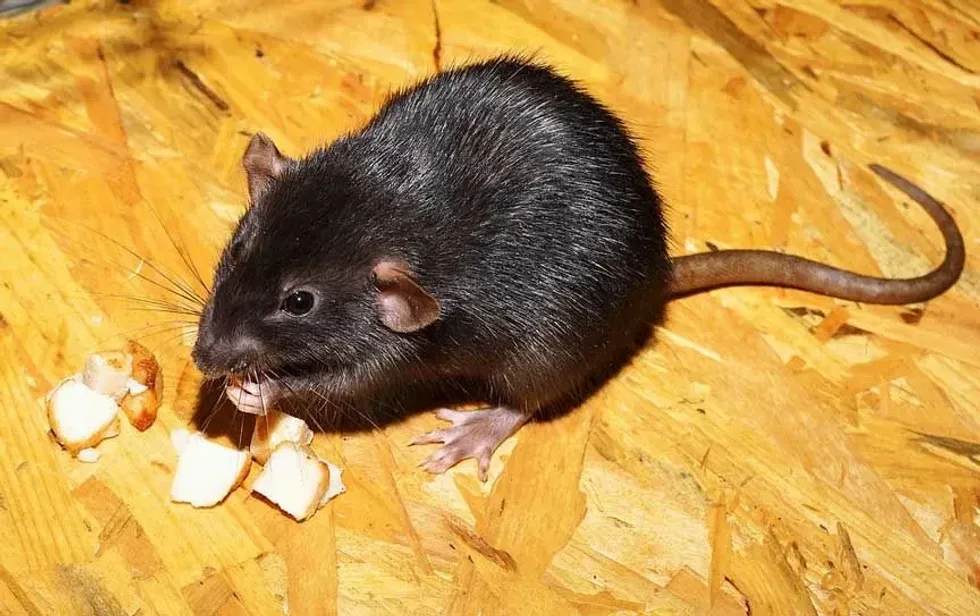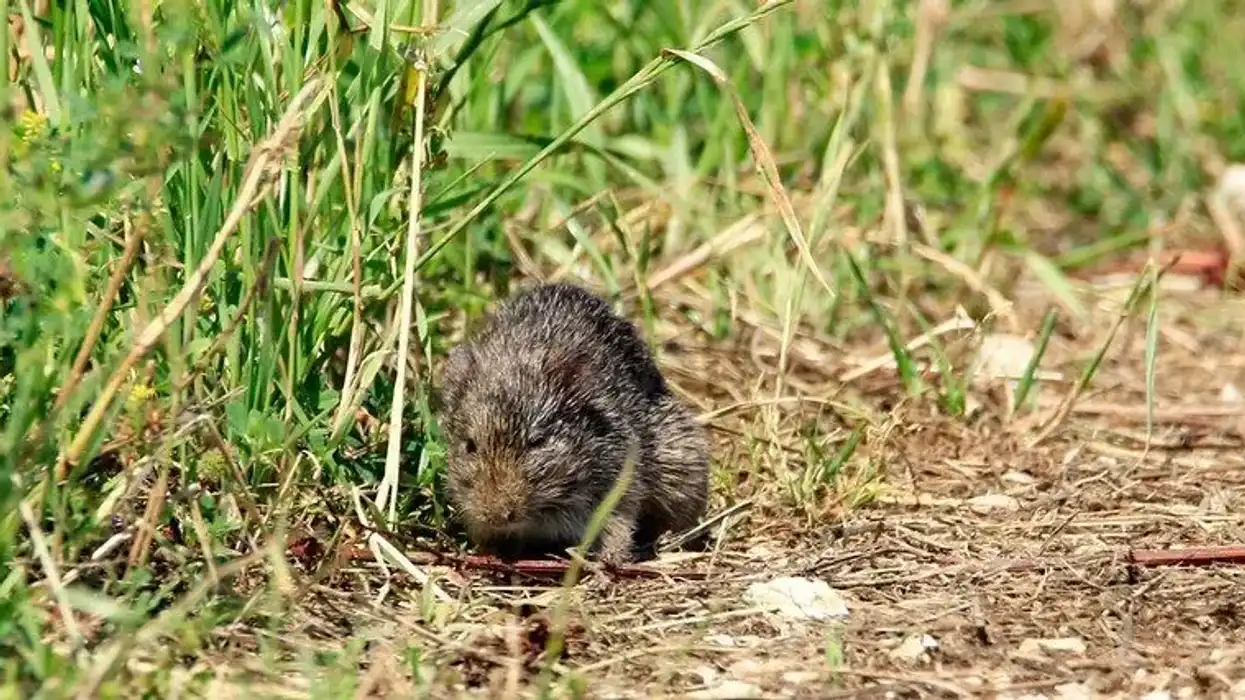Black rats (Rattus rattus) are commonly known as house rat, ship rat, or roof rats. Black rats are similar in appearance to a brown rat (Rattus norvegicus), and have gray-brown fur which can turn completely black.
Black rats are great climbers, and they are mostly found in palm trees. They forage on the ground for food and feed on fruits, seeds, worms and flies but can eat almost anything. Black rats carry harmful bacteria, which may cause many diseases in human beings.
Black rats habitat is in the vicinity of human populations. Black rat behavior makes them live in polygynous groups with multiple males and females wherein dominant males have more mating access than subordinate males.
These ship rats are the most common rat species and are found everywhere in the world, they were also responsible for the bubonic plague. The fleas on their body carry multiple diseases which are extremely dangerous to humans. The conservation status of black rats is listed as of the Least Concern, and their population is stable.
After reading these facts on the black rat invasive species, do check out our other articles on weasel and squirrel.
Black Rat Interesting Facts
What type of animal is a black rat?
Black rat (Rattus rattus) is a long-tailed rodent that belongs to the class muridae. They are common rats and can be found worldwide.
Black rats live in areas of human habitation in order to survive on food waste. This ship rat typically eats fruits, seeds, and leaves but can nibble on anything that this species find. They are also listed as invasive species.
What class of animal does a black rat belong to?
The black rat is a mammal and is given the title of true rats. This species is the most ordinary rat species which are found everywhere in the world. They are omnivorous in nature and feed on both plant and animal material.
How many black rats are there in the world?
The conservation status of black rats is listed as Least Concern and invasive. The three most invasive rat species are black rats, brown rats, and Norway rats.
The population of these rats explodes every 48 years. Due to their arboreal nature, black rats often tend to climb on thatched roofs and are known as roof rats. This species feeds on food waste, insects, seeds, and leaves.
Where does a black rat live?
Black rats live as house rats where there is a large number of human population. They also habitat in the woods, farms, houses, and tropical rainforests.
This species can also survive in areas where the vegetation is minimal, like islands. They are also found near coastal areas and swamps as they are good swimmers. Forests and shrublands are their preferred habitats.
What is a black rat's habitat?
Black rats can survive in warmer climates, and a tropical to moderate weather condition is best suited for them. Their origins are traced back to India, but the exact native location is unclear.
This species needs warm shelter during extreme cold and are most likely to cause rampage in a human household for food supplies. During the winter season, humans have to suffer from rat infestations in their houses and problems with pest control.
They easily adapt to urban areas and also undergo breeding, causing further destruction to property. Black rats can also be find on Oceanic islands.
Who do black rats live with?
Black rats live in small groups called packs. There are only two goals of any rodent, which are to collect food, and mate. Black rats can mate within their packs. Black rats are nocturnal in nature and carry out their foraging activities during the night.
How long does a black rat live?
Black rats have an average lifespan of 12 months in the wild. Some black rats which are domesticated can live for a longer lifespan. Black rats are rodents and would not make good pets as their only goal is to forage and mate. This species might even show aggressive behavior and bite the owner if they feel threatened.
How do they reproduce?
Black rats have exceptional breeding capabilities and reproduce ten to 12 times in a year. The average litter size of a black rat between five and six babies per litter.
This species reaches sexual maturity after completing four to eight weeks of their lifespan. In less than 25 days after their first litter, black rats can undergo breeding again and give birth to a new litter. The gestation period in black rats lasts for about three weeks.
What is their conservation status?
The conservation status of black rats is of the Least Concern and their population is abundant. This species can be found worldwide, living alongside human populations in urban areas. The population of black rats is invasive, along with brown rats and Norway rats.
Black Rat Fun Facts
What do black rats look like?
Black rats are stereotypical rats. This species can be found almost anywhere in the world. They are rodents and have long tails. The fur is short and the ears are round.
The color of the fur ranges from pale gray-brown to black. The tail is uniformly black to dark gray in color. These animals look indistinguishable from the brown rat and are nocturnal in nature. They also are arboreal and can be found on rooftops and trees.
How do they communicate?
Black rats communicate with each other by emitting ultrasounds which cannot be understood by human beings. Domesticated black rats can bare their teeth, pounce or grunt if these animals feel threatened. They also use their pheromones to communicate with other members of the pack.
How big is a black rat?
Roof rats have an average weight of 0.33-0.61 lb (0.14-0.27 kg). They are usually larger in size when compared to a mouse. These animals are 13-18 in (33-45 cm) of length and have a long tail which is relatively longer than the body. The Rattus rattus is a medium-sized rat and has circular ears.
How fast can a black rat run?
Black rats can run at an average speed of 8 mph (12 kmph) and can reach a maximum speed of 13 mph (20 kmph). These animals are rodents and are arboreal. They can tread on water for three days and are excellent swimmers. These animals also can climb a tree at a fast pace.
How much does a black rat weigh?
An adult black rat weighs anywhere between 0.33-0.61 lb (0.14-0.27 kg). Black rats are smaller than brown rats. These animals are medium-sized rodents and forage the ground during the night for finding food. They are identical in appearance to brown rats but have a slim body.
What are the male and female names of the species?
Male black rats, or any other male species of rats, are called bucks. The virgin females are known as does, and pregnant female black rats are called dams. Black rats are opportunistic feeders and have been living in human habitations, invading their homes during the winter season and searching for food. Rats, in general, are also known as commensals.
What would you call a baby black rat?
A roof rat baby is called an infant, kitten, or pup. A female black rat can give birth to 2000 pups during her entire lifespan. Black rats reproduce ten to 12 times in a span of 12 months and the average litter size of black rat is five to six pups.
What do they eat?
Black rats survive on a diet of plants, seeds, fruits, insects, and worms. These animals are omnivores in terms of their diet and can eat absolutely anything.
They live in areas where the human population is stable in order to feed on food waste dumped by humans. They feed only when an opportunity arises, and their diet consists of various foods like sugar cane, berries, fungi, and grains. These animals also are a threat to many farmers as they are capable enough of destroying any field.
Are they dangerous?
A big black rat can pose a serious threat to human beings as they are potent enough to spread many deadly viruses and diseases through their urine like hantavirus, leptospirosis, Well’s disease. salmonella, listeria, and toxoplasma gondii.
The black death, or the bubonic plague, caused by black rats occurred in 1346 in Eurasia and North Africa, and killed millions of people.
Would they make a good pet?
Black rats (Rattus rattus) can be domesticated, but they will often show aggressive behavior if caged. They are not as good as fancy rats, which make good house pets. Black rat pets may also try to escape the cage and cause major destruction in the house.
Did you know...
Black rats contain fleas and bacteria on their body which are very deadly and cause septicaemic and pneumonic plagues. Black rats use their long tails for balance while moving or foraging the ground and climbing.
Brown rat vs black rat
A brown rat is usually larger in size when compared to a black rat. The brown rat has a blunt nose and a large body. Although both these rat species are similar in appearance, the black rat has round, circular ears, a physical trait which is absent in brown rats.
Fun facts about black rats
Black rats have poor vision and can communicate by emitting ultrasounds. They cannot fight their predators and will usually flee from the scene.
They are naturally shy and tend to be anxious if they are left behind by their pack and are forced to live a solitary life. Black rats also have a good memory and can remember directions for their entire life.
Here at Kidadl, we have carefully created lots of interesting family-friendly animal facts for everyone to discover! Learn more about some other mammal including rice rat, or naked mole-rat.
You can even occupy yourself at home by drawing one of our rat coloring pages.










